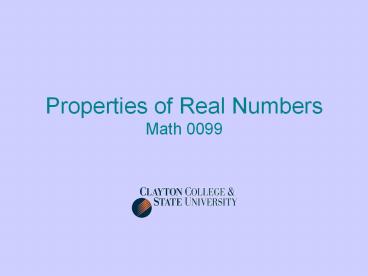Properties of Real Numbers Math 0099 - PowerPoint PPT Presentation
1 / 33
Title:
Properties of Real Numbers Math 0099
Description:
Properties of Real Numbers Math 0099 Opposites Two real numbers that are the same distance from the origin of the real number line are opposites of each other. – PowerPoint PPT presentation
Number of Views:121
Avg rating:3.0/5.0
Title: Properties of Real Numbers Math 0099
1
Properties of Real NumbersMath 0099
2
Opposites
- Two real numbers that are the same distance from
the origin of the real number line are opposites
of each other. - Examples of opposites
- 2 and -2 -100 and 100 and
3
Reciprocals
- Two numbers whose product is 1 are reciprocals
of each other. - Examples of Reciprocals
- and 5 -3 and
4
Absolute Value
- The absolute value of a number is its distance
from 0 on the number line. The absolute value of
x is written . - Examples of absolute value
5
Commutative Property of Addition
- a b b a
- When adding two numbers, the order of the
numbers does not matter. - Examples of the Commutative Property of Addition
- 2 3 3 2 (-5) 4 4 (-5)
6
Commutative Property of Multiplication
- a ? b b ? a
- When multiplying two numbers, the order of the
numbers does not matter. - Examples of the Commutative Property of
Multiplication - 2 ? 3 3 ? 2 (-3) ? 24 24 ? (-3)
7
Associative Property of Addition
- a (b c) (a b) c
- When three numbers are added, it makes no
difference which two numbers are added first. - Examples of the Associative Property of Addition
- 2 (3 5) (2 3) 5
- (4 2) 6 4 (2 6)
8
Associative Property of Multiplication
- a(bc) (ab)c
- When three numbers are multiplied, it makes no
difference which two numbers are multiplied
first. - Examples of the Associative Property of
Multiplication - 2 ? (3 ? 5) (2 ? 3) ? 5
- (4 ? 2) ? 6 4 ? (2 ? 6)
9
Distributive Property
- a(b c) ab ac
- Multiplication distributes over addition.
- Examples of the Distributive Property
- 2 (3 5) (2 ? 3) (2 ? 5)
- (4 2) ? 6 (4 ? 6) (2 ? 6)
10
Additive Identity Property
- The additive identity property states that if 0
is added to a number, the result is that number. - Example 3 0 0 3 3
11
Multiplicative Identity Property
- The multiplicative identity property states that
if a number is multiplied by 1, the result is
that number. - Example 5 ? 1 1 ? 5 5
12
Additive Inverse Property
- The additive inverse property states that
opposites add to zero. - 7 (-7) 0 and -4 4 0
13
Multiplicative Inverse Property
- The multiplicative inverse property states that
reciprocals multiply to 1.
14
Identify which property that justifies each of
the following.
- 4 ? (8 ? 2) (4 ? 8) ? 2
15
Identify which property that justifies each of
the following.
- 4 ? (8 ? 2) (4 ? 8) ? 2
- Associative Property of Multiplication
16
Identify which property that justifies each of
the following.
- 6 8 8 6
17
Identify which property that justifies each of
the following.
- 6 8 8 6
- Commutative Property of Addition
18
Identify which property that justifies each of
the following.
- 12 0 12
19
Identify which property that justifies each of
the following.
- 12 0 12
- Additive Identity Property
20
Identify which property that justifies each of
the following.
- 5(2 9) (5 ? 2) (5 ? 9)
21
Identify which property that justifies each of
the following.
- 5(2 9) (5 ? 2) (5 ? 9)
- Distributive Property
22
Identify which property that justifies each of
the following.
- 5 (2 8) (5 2) 8
23
Identify which property that justifies each of
the following.
- 5 (2 8) (5 2) 8
- Associative Property of Addition
24
Identify which property that justifies each of
the following.
25
Identify which property that justifies each of
the following.
- Multiplicative Inverse Property
26
Identify which property that justifies each of
the following.
- 5 ? 24 24 ? 5
27
Identify which property that justifies each of
the following.
- 5 ? 24 24 ? 5
- Commutative Property of Multiplication
28
Identify which property that justifies each of
the following.
- 18 -18 0
29
Identify which property that justifies each of
the following.
- 18 -18 0
- Additive Inverse Property
30
Identify which property that justifies each of
the following.
- -34 ??1 -34
31
Identify which property that justifies each of
the following.
- -34 ??1 -34
- Multiplicative Identity Property
32
Least Common Denominator
- The least common denominator (LCD) is the
smallest number divisible by all the
denominators. - Example The LCD of is 12 because
12 is the smallest number into which 3 and 4 will
both divide.
33
Adding Two Fractions
- To add two fractions you must first find the
LCD. In the problem below the LCD is 12. Then
rewrite the two addends as equivalent expressions
with the LCD. Then add the numerators and keep
the denominator.






























